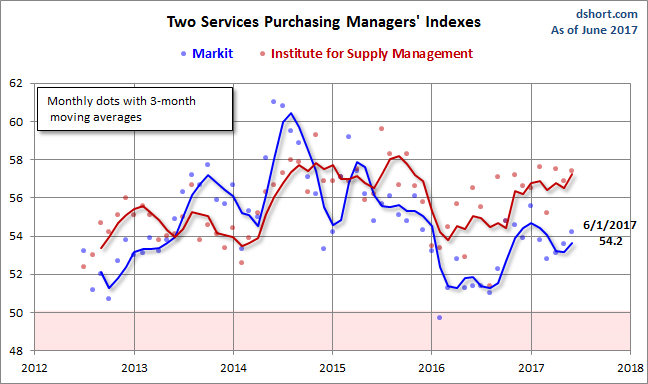The June US Services Purchasing Managers’ Index conducted by Markit came in at 54.2 percent, up 0.6 percent from the May estimate. The Investing.com consensus was for 53.0 percent. Markit’s Services PMI is a diffusion index: A reading above 50 indicates expansion in the sector; below 50 indicates contraction.
Here is the opening from the latest press release:
Business activity in the US service sector increased at the fastest pace since January in June, according to the latest survey data. Meanwhile, accelerations in new order and employment growth supported increased optimism in the sector. On the price front, input price inflation was the fastest since June 2015, while output charges rose at the strongest pace in the current 16-month sequence of inflation.
The seasonally adjusted IHS Markit U.S. Services Business Activity Index registered 54.2 in June, up from 53.6 in May. This signalled a third month of accelerated growth in business activity among US service providers. Panellists linked growth to increased new orders and strong client demand. Overall, activity during the second quarter expanded at a solid pace that was only fractionally softer than that seen in the first quarter. [Press Release]
Here is a snapshot of the series since mid-2012.

Here is an overlay with the equivalent PMI survey conducted by the Institute for Supply Management, which they refer to as “Non-Manufacturing” (see our full article on this series here). Over the past year, the ISM metric has been significantly the more volatile of the two.

The next chart uses a three-month moving average of the two rather volatile series to facilitate our understanding of the current trend. Since early in 2016, the ISM metric has shown stronger growth than the Markit counterpart. It will be interesting to see how these two indicators play out for the remainder of 2017.

Both series weakened since 2015 and saw an uptick in the later half of 2016. The interim three-month moving average of the Markit Services index peaked in August of 2014. The ISM index peaked in September of 2015. The two were fairly closely aligned at the beginning of 2016, but they diverged early with the Markit index signaling noticeably weaker growth.













Leave A Comment